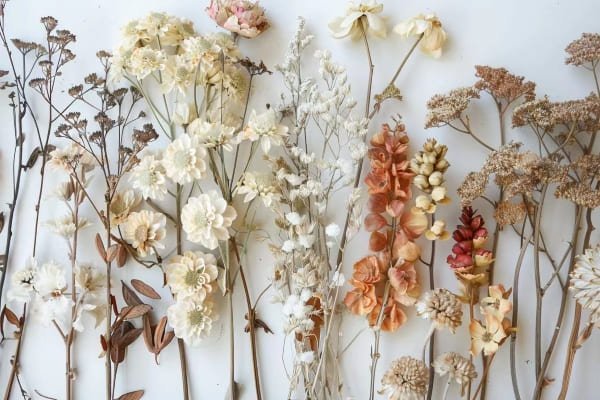


Dried flowers have captured human imagination for centuries, used in everything from art and decor to culinary and medicinal applications. Their enduring beauty lies in their preserved state, which allows them to maintain their form and color long after they have been cut. This guide will explore various dried flower preservation techniques, delving into the methods and best practices to ensure that your dried flowers retain their beauty and usefulness. We will also discuss the applications and benefits of dried flowers, emphasizing their versatility and sustainability.
Dried flower preservation is not a modern invention. Ancient civilizations such as the Egyptians, Greeks, and Romans used dried flowers for ceremonial purposes, medicinal practices, and as decorative elements. The Victorian era saw a surge in the popularity of dried flowers, particularly in the form of herbariums and floral arrangements. Understanding this historical context highlights the enduring appeal and significance of dried flowers across cultures and time periods.
Air drying is the simplest and most traditional method of drying flowers. It involves hanging flowers upside down in a dry, dark, and well-ventilated area.
Air drying works well for flowers with sturdy stems and low moisture content, such as lavender, roses, and hydrangeas.
Pressing flowers is ideal for preserving their shape and color in a flat form, perfect for use in art and crafts.
Pressing is suitable for delicate flowers like pansies, daisies, and violets, which flatten easily without losing their shape.
Silica gel drying is a more advanced method that involves using silica gel crystals to absorb moisture from the flowers, preserving their shape and color more effectively.
Silica gel drying is ideal for more delicate and intricate flowers like roses, dahlias, and peonies, which can retain their vibrant colors and shapes.
Microwave drying is a quick method that uses a microwave to speed up the drying process, often in conjunction with silica gel.
Microwave drying works well for quick projects and flowers that are needed immediately, such as small roses and daisies.
Glycerin preservation involves using glycerin to replace the water in the plant's cells, keeping the flowers flexible and retaining their color.
Glycerin preservation is suitable for flowers with woody stems and leaves, such as eucalyptus and magnolia leaves.

Dried flowers have a wide range of applications, each benefiting from different preservation methods.
Dried flowers can be used to create long-lasting floral arrangements and bouquets that add a touch of nature to any room. They are particularly popular for rustic and vintage-themed decor.
Wreaths and garlands made from dried flowers are perfect for seasonal decorations, adding a natural and festive touch to doors, mantels, and walls.
Pressed and framed dried flowers make for stunning wall art, preserving the beauty of nature in a timeless display.
Pressed flowers can be used to create beautiful, personalized greeting cards for any occasion, adding a unique and thoughtful element to your messages.
Dried flowers can be embedded in candles and soaps, adding a decorative and aromatic touch to these homemade gifts.
A blend of dried flowers, herbs, and essential oils can create fragrant potpourri, perfect for freshening up rooms and closets.
Certain dried flowers, such as lavender, rose petals, and chamomile, can be used in cooking and baking, adding unique flavors and decorative elements to dishes and desserts.
Dried flowers like chamomile, hibiscus, and jasmine are commonly used to make soothing herbal teas, enjoyed for their flavor and health benefits.
Dried flowers have been used in traditional medicine for centuries. Flowers like calendula, echinacea, and elderflower are valued for their healing properties and are used in various herbal remedies.
Dried flowers can be used to create essential oils, which are popular in aromatherapy for their calming and therapeutic effects.
Dried flower sachets can be placed in drawers, closets, and cars to impart a pleasant fragrance and keep spaces smelling fresh.

Store dried flowers in a cool, dry place away from direct sunlight to prevent fading and moisture damage. Use airtight containers or plastic bags to protect them from dust and pests.
Dried flowers are delicate and can easily be damaged. Handle them with care, using tweezers or gloves if necessary, to avoid crushing or breaking petals and stems.
Periodically check your dried flowers for signs of deterioration, such as mold or discoloration. Remove any damaged flowers to prevent the spread of mold or decay to other flowers.
Applying a clear sealant spray to dried flowers can help protect them from moisture and dust, prolonging their lifespan and keeping them looking fresh.
Dried flower preservation is a time-honored practice that combines art, science, and nature. By mastering various techniques such as air drying, pressing, silica gel drying, microwave drying, and glycerin preservation, you can ensure that your dried flowers retain their beauty and usefulness for years to come. Whether used for home decor, crafts, culinary, or medicinal purposes, dried flowers offer endless possibilities and benefits. With proper care and creativity, you can transform simple blooms into lasting works of art that bring joy and beauty to any space.